The caracal is one of Africa’s ultimate hunters, a stealthy cat with an exceptional ability to hunt out prey on the savanna.
To encounter a caracal is an African safari’s utmost treat. Many people living on the continent go decades before spotting one of these extraordinary creatures.
Yet countless safari adventurers lack appreciation when this elusive predator is observed. It’s way down on the list of favorite wildlife sights, but it shouldn’t be.
Are caracals dangerous? Do they have aggressive personalities? And can they live outside of the wild?
Read along as we answer some of the most burning questions you might have about this fascinating animal.
Fascinating Facts About the African Caracal That Might Surprise You
Let’s take a look at 21 incredible caracal facts so you can learn all about this astonishing animal and its intriguing behavior.
1. What does ‘caracal’ mean?
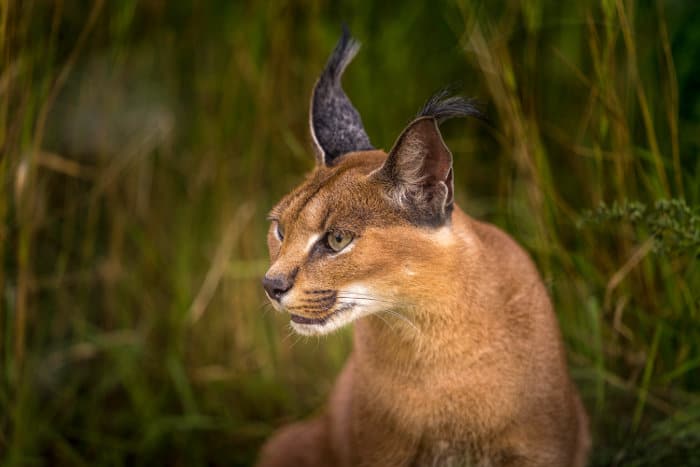
The word ‘caracal’ is a French word that draws from the Turkish kara kulak:
- Kara = black
- Kulak = ear
The caracal’s black ears are arguably its most distinctive feature, sticking up and twisting in all directions, like a periscope on a submarine.
2. Is a caracal dangerous?
Quite simply, yes.
Though a caracal is not likely to wait for you to fall asleep and rip your face off on the first day, it is a cat and a wild one at that.
A caracal has the genetic makeup and tools to attack anything and anyone that it deems to be dangerous. Do caracals attack humans? Well, it is rare but still possible if the animal feels threatened.
A caracal has sharp fangs with the exclusive remit of biting to rip, shred and kill. Its retractable claws are not primarily there for scratching an itch behind its ear.
They are for slashing at possible threats and sticking into a rival’s flesh to cause harm.
3. Caracal’s closest kin
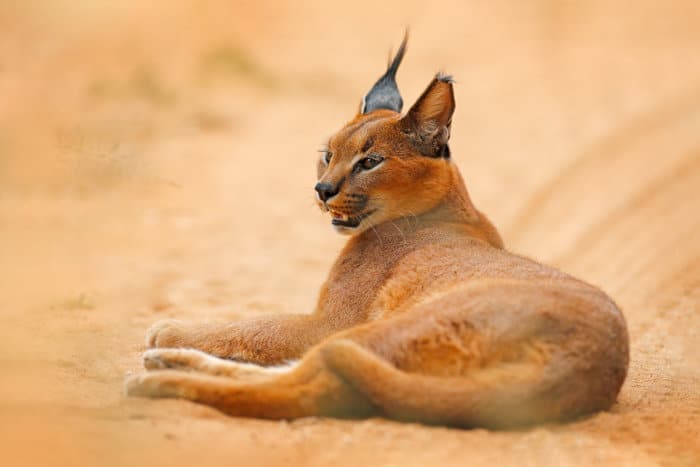
In terms of appearance, the caracal and the common house cat share similarities, like the small, almost spherical head with tiny marble-like eyes.
However, the caracal’s closest relative is the even rarer and more elusive African Golden Cat.
Interestingly, safari enthusiasts frequently misidentified the caracal and the African Golden Cat for the serval cat, another close relative.
Despite a nearly identical body shape and structure, there are two easy-to-see differences:
- Caracals don’t have the serval’s black spots.
- Servals don’t have the caracal cat’s distinctive ear tufts.
4. How big is a caracal cat?
Caracals can reach 1 meter (3.2 ft) in length and about 18 kg (40 lbs) in weight. Males are always slightly heftier than their female partners.
The caracal takes a spot midway up on the size chart of the planet’s cats. It’s big enough to take care of itself and fend off a foe, but not quite big enough to mix it with the might of the apex predators.
5. Caracal cat ears are easy to identify
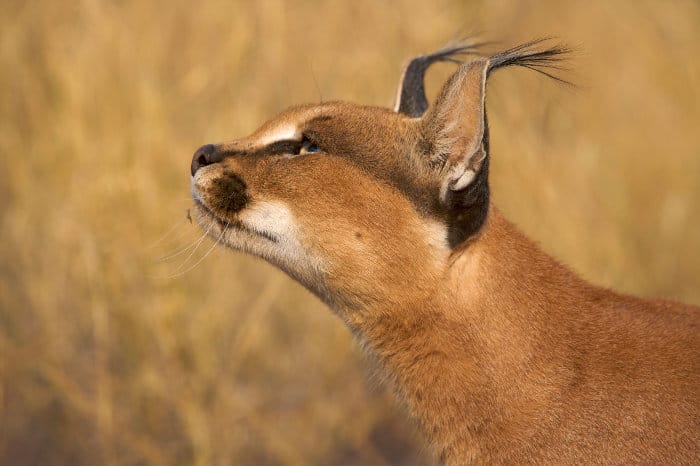
A caracal has ears that seem to be constantly pricked up in readiness or on alert. An amazing 20 muscles control these unnaturally long and pointy sound detectors, making it the mobile satellite system of the cat family.
These super-sensitive audio antennas are made even more effective by the tufts of hair that protrude from the top. They act as a funnel to capture and reverberate the slightest sound picked out of the air.
6. How high can a caracal jump?
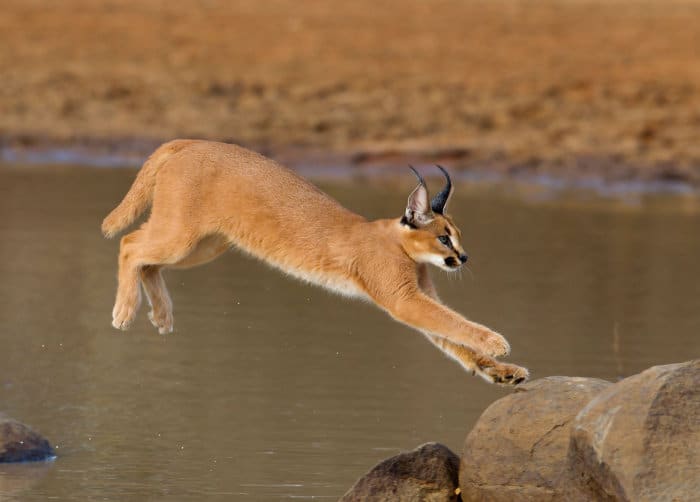
Although one of the smaller members of the wild cat congregation, what caracals lack in brute force they make up for with astounding agility.
The caracal cat can leap as high as 3 meters (10 ft), frequently after silently stalking and then sprinting down its prey.
Often seen batting birds out of the sky, straight after terrified take-off, the reactions and coordination of these medium-sized cats are unparalleled.
7. How fast is a caracal?
The caracal can reach rates of 80 km/h (50 mph) when in full flight. These smaller wildcats debunk the misconception that bigger ones corner the market on sprinting speed.
Subscribing to the same hunting techniques as most of its feline family, it doesn’t possess the deepest stores of stamina. So, a skillfully sly approach without detection is key for any successful hunt.
8. What do caracal cats eat?

As is the case with all other members of the cat family, from the smallest tabby cat to the largest Siberian tiger, the caracal feeds upon a mostly meat-based diet.
Due to size and power constraints, it would be overambitious of a caracal to try and take down a zebra or oryx like its bigger cousins, the African leopard or lion.
The caracal satisfies itself with a mixture of more miniature morsels – rodents, birds, and rabbits.
But it doesn’t shy away from the odd bulkier-bodied bounty such as gazelle or some of Africa’s smallest antelope species.
9. Caracals don’t need to drink water (often)
Caracals are the camels of the cat family. They are hypercarnivores, meaning that they can extract water from food and don’t need to rehydrate as often as other cats.
This specialist attribute allows it to sustain itself throughout long-distance treks across dry, arid lands in search of nutrition.
In short, the caracal cat can roam further from the water, which means it can find its own food, away from the competition of lions and leopards.
10. You should not own a caracal as a pet
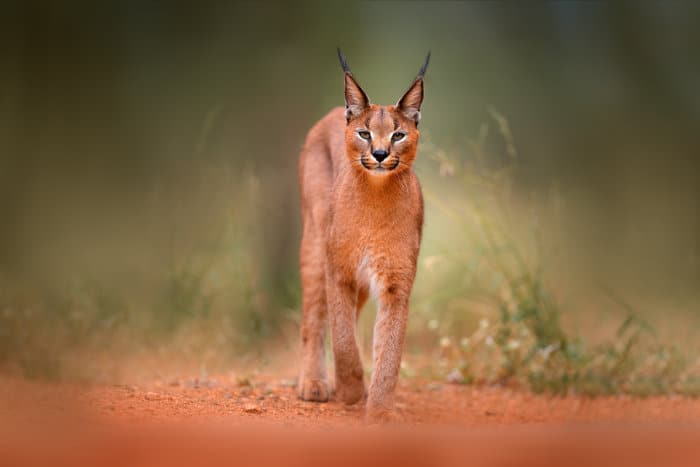
Throughout history, the rich and famous have wanted to buy and cage the world’s wildest animals as status symbols.
It seems there’s an inane need to show a sense of superior power by taking the universe’s most magnificent creatures and enslaving them.
What is thought to be an exhibition of exuberance is actually just a sure sign of low self-esteem.
The caracal is a wild animal that should not be in captivity, nor should any of Africa’s magnificent cats.
So let’s be clear – caracals should never be pets. They are the wild inhabitants of the African savanna.
11. Did Mike Tyson own wild animals?
Mike Tyson – once known as ‘the baddest man on the planet’ – recently confessed to a feeling of regret for owning pet tigers.
Baddest man on the planet or not, if it had been so inclined, his ‘pet’ tiger could have snapped his neck with one brutish bite and chomped on him like a chew toy.
Mike Tyson was a product of his harrowing upbringing and environment.
Tigers are a consequence of years of evolution and predisposed nature.
They don’t maul and maim because they’re evil, vindictive, or in pain.
They do it because that’s what cats do.
This sometimes cruel and callous custom of finding ways to control and restrict those who thrive on freedom, has stretched its paws and reached its claws as far as the caracal.
12. Wild cats will be wild cats, including the caracal
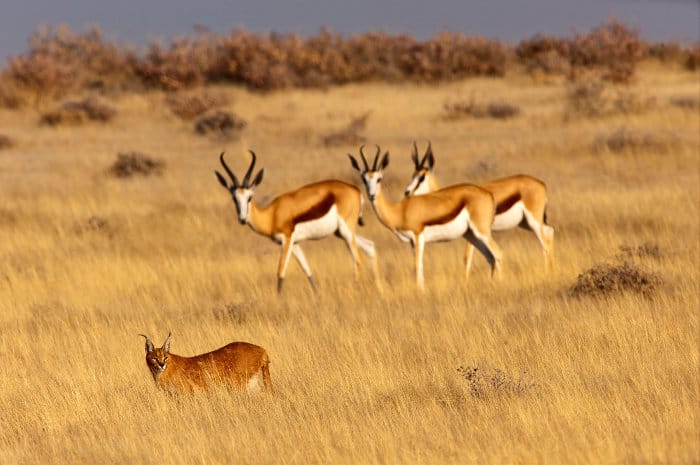
When we see some of the planet’s proudest predators burrowing their heads into a slain animal’s rib cage, some of us mistakenly view them as cold-blooded killers.
Emotion does not come into it. They are programmed to follow their animal instincts. And they will do it again without a second thought once the brain sends the necessary signal to indicate that they are hungry.
Every single member of the cat clan is designed to survive, defend, and attack. Nothing else is of any interest or importance.
For more information on animals’ instinctive behavior, check out this article.
13. The caracal has a strong bite force
Although the mighty jaguar takes the top spot for the strongest bite of all big cats, the caracal has strong jaw muscles as well.
The caracal bite force is 168.5 Newtons. To put that in perspective, a typical house cat’s bite force is 73.3 Newtons, and the bite force for dogs is 13-1394 Newtons, depending on breed.
Caracals prefer to bite their prey on the underside of its throat or the back of the neck. So to avoid a caracal bite, sleep on your side (joke).
14. Can a caracal kill a human?

If you’re wondering, ‘can caracals kill humans’ or if they would, simply put, these powerful hunters prefer looking for prey to harming a human.
While they are wild animals, caracals are small, fast cats that would often run away from identified danger.
Now, if you keep one as a pet (which we said NOT to do), then you might be in trouble. The few known attacks to humans have been from caracals kept in captivity.
15. Why do caracals hiss so much?

Some may mistake the caracal hissing meaning for aggressive behavior, but these sounds are ultimately a form of cat communication.
They use sounds like hisses, growls, and twittering meows to express their mood, much like a content-purring.
16. Why are caracals called ‘The Barking Cat’?
The caracal is not part dog, but it is called the barking cat for a reason. However, it doesn’t bark in response to a doorbell ringing or to chase a cat.
Caracals use their cough-like bark for two main purposes:
- Calling out to a partner
- Warding off danger
But caracals won’t bark just because they’re grumpy. Instead, they’ll hiss, growl, or even more ‘charmingly,’ spit.
17. Caracals are essential rodent control
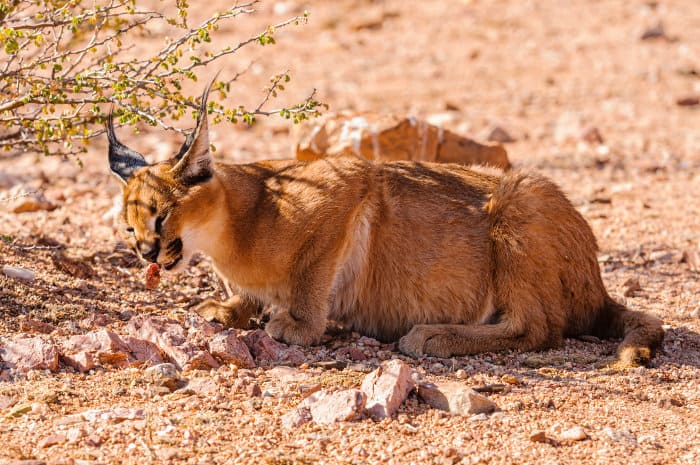
Caracals can hunt prey up to three times their mass, like small monkeys and antelope. But rodents make up a large portion of their diet.
It’s like a barn cat, but for the savanna. Without caracals’ help, the rodent population could become out of control.
Other modestly sized tasty caracal cat treats include:
- Meerkats (Stay safe, Fizzle)
- Mongoose
- Birds
- Hyraxes (dassies)
18. Why are Cape Town’s caracals full of poison?
Cape Town’s caracals are full of rat poison. A study found that 92% of caracals in the greater Cape Town area were impacted. The worst areas were near wine farms.
Other species impacted by humans’ love of chemical rodent killers include:
- Cape clawless otters
- Large spotted genets
- Honey badgers
- Water mongoose
- Small grey mongoose
- Cape eagle owl
Given how all these animals love to snack on rats, maybe we should just let them do their job instead of making them sick?
19. (Big) cats eat caracals

Humans and their love of rat poison are not the only predators caracals face. Caracal cats also need to worry about cats.
Admittedly, it isn’t the common house cat giving caracals problems. Instead, the trouble comes from the more usual suspects:
- Lions
- Leopards
- Hyenas
Caracals protect themselves by lying flat in the savanna grasses, their plain coats blending in. They also avoid their predators by venturing further away from water sources.
20. Caracals don’t mate for life
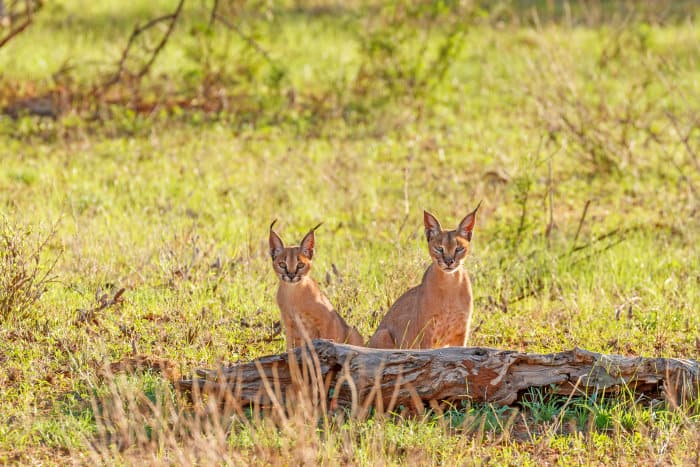
Caracals are independent animals that mostly respect each other’s territory but don’t like to be best buds. There is no ‘happily ever after’ love story in a caracal’s life.
Instead, when a female caracal is in the mood, she might mate with up to three males. Then she saunters off to have her babies alone. Yes, caracals are all about single motherhood.
Female caracals carry their kittens for an average gestation period of 79 days. Afterwards, she gives birth to a litter of 2-4 kittens.
Caracal kittens leave their mothers around 9-10 months old. However, some female kittens will stay with mom for a little over a year.
21. Caracals don’t just live in Africa
The caracal is an African treasure. Nevertheless, they live in other parts of the globe, including in the Middle East and Central Asia.
Caracals are not endangered. In South Africa and Namibia, their populations are considered healthy.
That being said, they are rare and threatened in certain parts of Asia and North Africa.
But because caracals are most active at night, it can be difficult to spot them even in the most populated areas. Their elusiveness makes an encounter an even bigger treat.
Venture into the Wild to See African Caracals
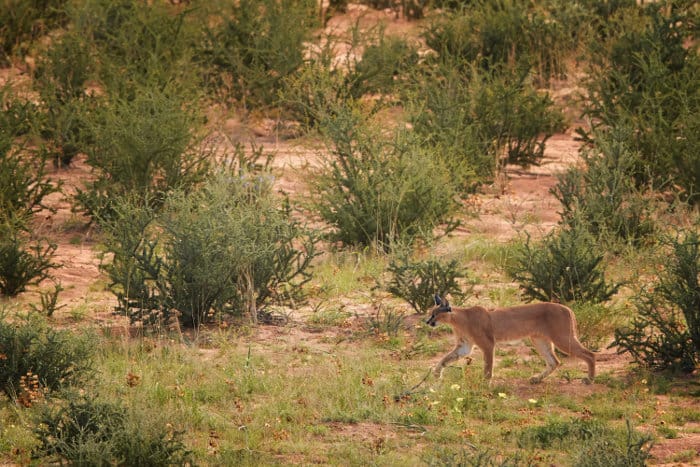
The caracal is a mesmerizing cat of great courage and beauty.
With its extraordinarily long and pointy ears and its freakish ability to fling itself metres in the air and almost fly, it is a predator to be feared and an animal to inspire awe.
The best place to see a caracal cat is in its natural habitat on an exhilarating African safari.
If you’re an animal lover, you’ll likely tick off several big cats from your sightseeing bucket list.
So start planning your trip and book those tickets – a wild adventure awaits you.
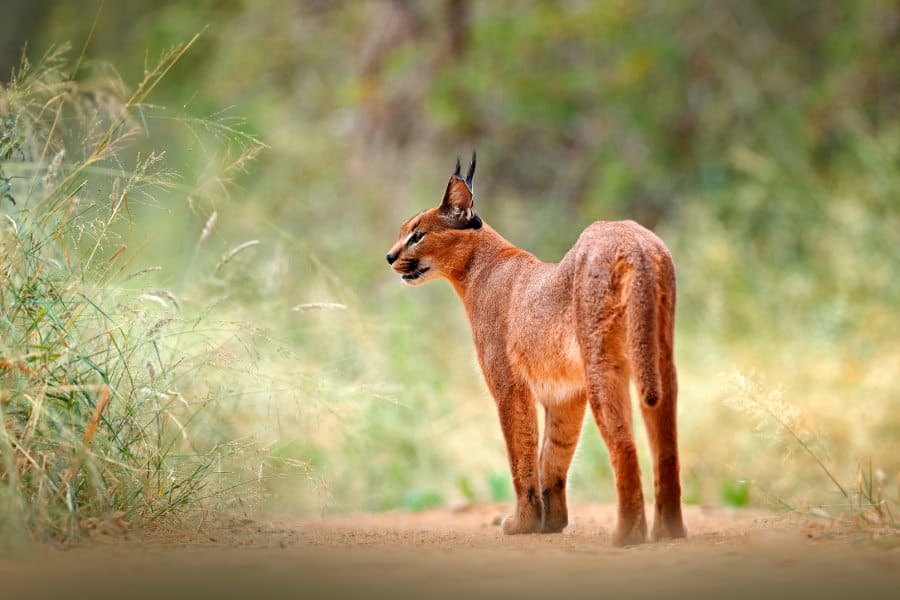
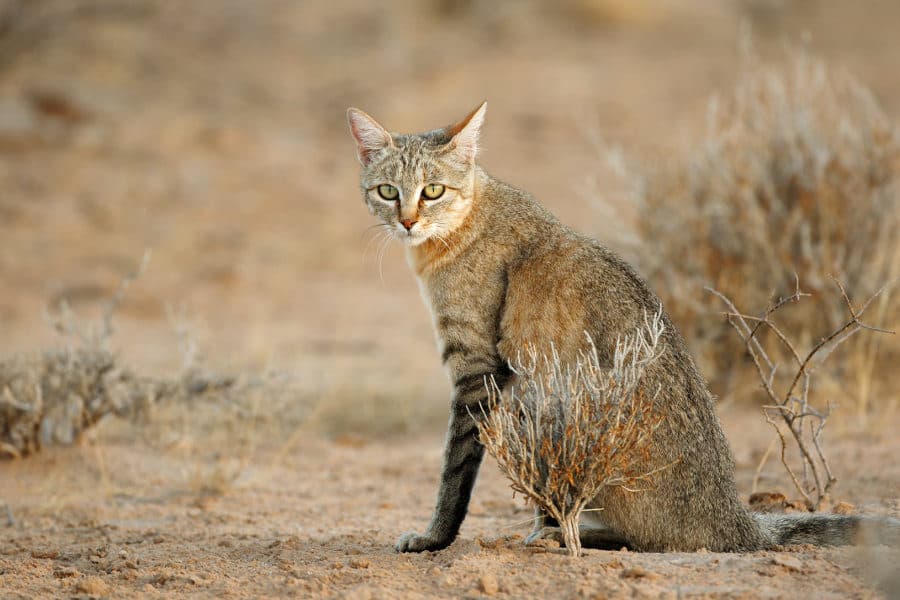


Great information, knowledgeable sites like this are always a joy. Quick question- are there domesticated cats similar to the caracal you recommend as pets?
I think THIS ARTICLE is the source of people thinking that when caracals hiss and growl it doesn’t mean they’re unhappy, like it does for every other cat. This caracal owner insists they don’t meow, and that hissing and growling are how they communicate. It is, but it’s communicating it’s unhappy. https://www.facebook.com/profile.php?id=100086308684624
I wish you could change the wording of the article to make it much more clear that caracals do indeed meow, and vocally communicate just like all other cats!
This is awesome … my nephew Jared loves caracals and architecture and I love to talk to him about his interest. :-]
Searing regards,
Kevin Lee
Happy you enjoyed the content, Kevin!
Hope this post inspires more interesting conversations with your nephew! 🙂
Take care,
Michael
The claim of not suitable to be a pet is just plain bullshit. To be clear, domestic cats never lose their hunting instincts either which is why there’s no cat that wouldn’t do fine in the wild if it needs to which is why they’re forever telling us to keep cats indoors so that they don’t eat the neighbours birds.
Caracals are suitable to be be pets, IN THE RIGHT ENVIRONMENT but then again, that’s what you need to provide for any pet. If a caracal is free to enter and to leave a house as it pleases and has enough outdoor territory to keep it interested, let’s be real here. It’s not going to avoid coming to and staying in a house, where it’s fed and is warm, safe and comfortable.